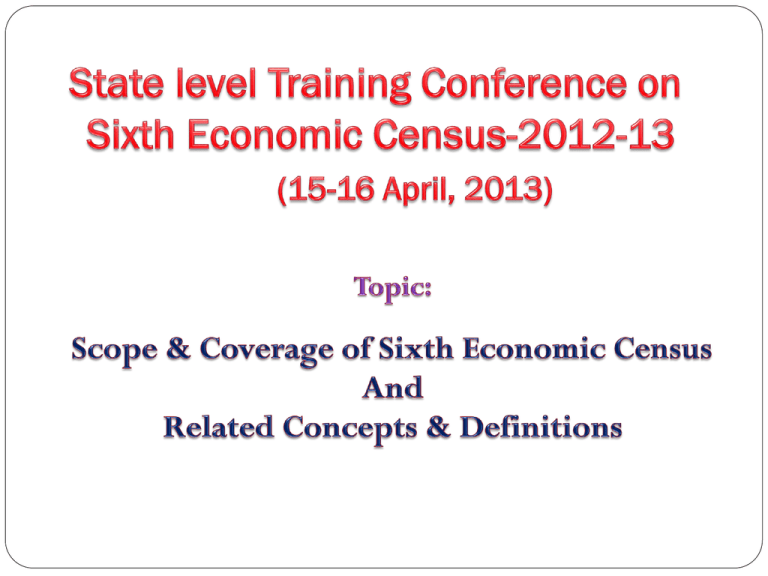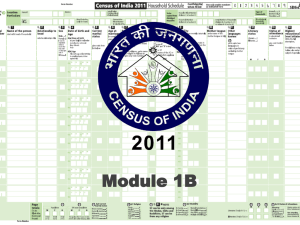PPT-presentation concepts Sixth EC 28 Aug
advertisement

Presentation is factored into the following: Censuses in India Importance & Usefulness Sixth Economic Census Scope & Coverage Concepts & Definitions of Important Terms How to identify an Establishment Handloom/Handicraft activity Nature of Entrepreneurial Activity Census House / Structure/Household Major Source of finance Ownership Use of Layout Map (LM) and Abridged House List (AHL) What is a Census: The process signifies complete enumeration or accounting of a unit; entity or subject of study. Different Censuses In India: Population Census Livestock Census Agriculture Census Minor Irrigation Census Census Cum Survey of Small Scale Units Economic Census Economic Censuses In India: Five Economic Censuses conducted so far 1977, 1980, 1990, 1998 & 2005 What is Economic Census: It is a census of all establishments/ enterprises located in the geographical boundaries of the country. It covers all establishments irrespective of their size in terms of employment, capital invested, turnover etc. It covers all active units whether registered or not. It covers all economic units operating within the household premises or outside having fixed structure or without fixed structure (or premises)- mobile units, vendors, hawkers etc. Why an Economic Census: To provide an up to date frame (list)of all live economic entities/establishments in the country from which samples could be drawn for collecting detailed information at a later stage. Information collected is always directly or indirectly useful for planning and policy making purposes. Assess contribution of various sectors of the economy through detailed follow up surveys based on the frame provided by the Economic Census. An important activity carried out by many statistical offices world over with the aim of improving availability and quality of existing basic economic statistics. Establishing or improving their survey frames or statistical business registers for the organization of economic survey programmes on a more integrated basis at a later stage. Scope & Coverage of Sixth Economic Census: Would cover whole of Indian Union except areas that remain inaccessible throughout the year and where State/UT Government find it impossible to carry out the field work. All economic entities/units engaged in production of goods or services and selling out whole or a portion of it are to be enumerated. All establishments irrespective of their (a) location (fixed or temporary) within the household premises or outside; (b) size of employment; c) size of investment/ turn over (d) number of hired workers etc. would be covered. Following Activities are outside the Scope of Sixth EC and have not to be accounted for (Exclusions) Scope & coverage (contd.) Exclusions: Agriculture: Establishments growing perennial and non-perennial crops including plantation crops e.g. growing of tea, coffee, rubber, tobacco plantation crops etc. Government Offices: Establishments engaged in public administration covering all ministries, departments at Central and State/UT Govt. level and also local Govt. This includes Courts, Tax Office, Offices of Ministry of Defence (Air Force, Navy and Army), Police, ESIC, EPFO. Defence production units/workshops: manufacturing or producing defence equipments or sensitive machinery or material. Establishments involved in Gambling and betting activities declared illegal by the Government. International organizations such as United Nations office and its specialized agencies 'offices, Foreign Embassies/Consulates etc. located with in the geographical boundary of the country. Inclusions: However, government schools/institutions, colleges, hospitals, hostels, guest houses, banks, all public sector undertakings/ corporations etc. would be covered. The broad activity types to be covered during the Sixth EC are shown below with their respective two digit category code: Concepts & Definitions of Important Terms: What is an Establishment: An establishment, for the purpose of Sixth EC, would mean as an enterprise or a part of an enterprise that is situated in a single location in which one or predominantly one kind of economic activity is carried out such that at least some part of the goods/services produced is meant for sale. Economic units producing goods or services for sole consumption within their household are excluded. An establishment may be a part of a multi-branch concern/company that has branches at different locations. In such a case each branch as well as headquarters will qualify as an establishment. For example, an establishment can be a shop selling the provisions of day-to-day consumption/ use, a factory producing or manufacturing goods item, or a house where an economic activity is carried out by the member(s) within the household by themselves or by hiring person(s) or with a combination of the two and selling their produce partly or fully. What is an Enterprise: An institutional unit in its capacity as a producer of goods and/or services is known as an enterprise. It is entrusted with the characteristics of an economic transactor with autonomy of financial and investment decision making; authority and responsibility for allocating resources for production of goods and services. It may be engaged in one or more economic activities at one or more locations. How to identify an Establishment: Bigger economic units and operating in the fixed structure or premises are easily identifiable. Whereas the problem of identification lies mainly in respect of the smaller/micro level units being operated within the household premises by the household members or without having any fixed structure. For example:- If the members of the household are carrying out activities like: providing tuition to members of other households Tailoring beedi making storing of vegetables or other items of trade operating from their household premises preparing cooked meals/other items, for selling in open markets/streets –Hawkers; mobile food units etc. then, such households will qualify for recording as establishments and are usually termed as household establishments and would be enumerated. Own Account Establishment: An establishment being operated without having any hired worker on a fairly regular basis. These are normally run by members of the household. Establishments performing more than one type of activity: It is possible that more than one type of activity (mixed functions/ activity) are carried out in and by the same establishment at one premises. If the multiple activities are carried out by the same set of workers side by side without specific allocation and book of accounts is also not prepared separately or accounts are not kept separately for each activity and it is also difficult to segregate the actual number of workers performing each specific activity, then major activity of the establishment should be recorded. For example, a grocery store also providing the services of public call telephone facility to the public within the same store. In this case, the major activity or the dominant activity of the establishment would be recognized on the basis of income or turnover/receipts or number of workers engaged in each of them depending on the information readily available. When different activities are carried out within the same premises but can be segregated out in terms of no. of workers, performing each of these with independent set of inputs / equipments then such cases would be treated as a case of multiple establishments and appropriate activity code(s) would be assigned. Agricultural Establishments: (Broad Activity Code ‘01’) Establishments engaged in providing supporting activities incidental to agriculture production and activities similar to agriculture not undertaken for production purposes done on a fee or contract basis. Activities included are post harvest crop activities, aimed at preparing agriculture products for the primary market; operation of pest spraying; preparation of field for cropping ; operation of irrigation system etc. Agriculture & Allied Activities: Activities allied to the agriculture (including hunting & trapping, livestock production, forestry and logging and fishing (Section A of NIC) fall in the broad activity codes 01 to 04 in Col. 12 of Schedule 6A and are to be included here. It may be noted that while the growing of tea, coffee, rubber, tobacco, etc. are not classified as agricultural establishments for the purpose of this census, however establishments engaged in processing of tea, coffee, tobacco etc. are to be covered and appropriate category code/NIC code be given. Non-agricultural Establishments: Establishments engaged in activities other than agricultural and allied activities as defined above will be termed as nonagricultural establishments. These are the activities which do not fall in the broad activity codes 01 to 04 and are covered under codes 05 to 23 in column 12 of Schedule 6A. What is Handloom/Handicraft activity: Handicrafts are items made by hand, mostly using simple tools. While they are predominantly made by hand, some machinery may also be used in the process. Skills are normally involved in such items/activities, but the extent thereof may vary from activity to activity. These items can be functional, artistic and/or traditional in nature. Handicraft products range from the simple (diyas) to the complex (stone temples, enamel jewellery). Handicraft products can have distinctive features often derived from their symbolic value to a society. Handloom items are still made by using human skills by the persons called “ Jullahyas”. The products like durries, curtains, carpet; khadi items are the examples. A list of activities recognized as handicrafts activity is given in Annexure 6 of the “Guide”. What is not considered as a handicraft activity? Activities involving human labour without skill are usually excluded. Two categories to be specifically excluded are:1. Manufacture of all food items like papads and pickles 2. Bricks, Beedis, agar batties ; match sticks and firecrackers Nature of Entrepreneurial Activity: If the entrepreneurial activity is carried out throughout the year, more or less regularly, it is then treated as a perennial activity. If the activity of the establishment is confined to a particular season, i.e. fixed months or period in a year, it is called as a seasonal activity. For example :- Sugarcane juice making units; fire crackers units. If the economic activity of the establishment is neither perennial nor seasonal, it will be termed as casual. Casual entrepreneurial activity is carried out occasionally depending upon the availability of time and resources. Workers in an Establishment: All persons (including children under 15 years of age) working in an establishment either as - Owner(s) including partner - members of the household (unpaid or paid) - hired or non-hired; regular salaried employees working in the capacity as - primary worker - Supervisor - Sales person for selling/marketing its produce or services of apprentices - supporting workers/helpers - casual/ daily wage labourers All put together would be considered as no. of persons working in the establishment. NOTE:- The owner running the establishment would also be considered as a worker and counted for the purpose. Structure or Building: It denotes in broader sense some kind of shelter erected on the ground following some civil engineering norms for construction using building material. However, the structure could be Kutcha, Semi-Pucca or Pucca. Census House: A census house is a building or a part of a building having a separate main entrance from the road or common courtyard or staircase, etc., used, or recognised as a separate unit. It may be occupied or vacant. It may be used for residential, commercial or for both purposes. What is a Household A household is a group of persons usually living together and taking their meals from a common kitchen.(Definition as per Population Census) Members in a household: It includes temporary stay-away (those whose total period of absence from household is expected to be less than six months) but excludes temporary visitors and guests (with expected total stay of less than 6 months). There may be a household of persons related by blood or a household of unrelated persons or having a mix of both. There may be single member households, two member households or multi member households. For Economic census purpose, each one of these types is regarded as a “Household”. Examples of household of unrelated persons and taking the meal from a common kitchen are boarding houses, messes, hostels, rescue houses, jails, ashrams etc. These are called ‘Institutional Households'. The important link to find out whether there is a household or not is the common kitchen. The following categories of households will be listed in the EC:1. 2. 3. 4. All households as defined in pervious slide ( individual households or institutional households) whether performing economic activity within its premises or outside it and qualifying to be counted as economic unit or establishment OR even if its members are simply wage earners/ salaried class etc. Civilian population residing in the premises including the family quarters of service personnel are to be covered. Institutions like Orphanages, Nari Niketans, etc will qualify for listing as establishments. Inmates of these would not be listed as single member households. Although inmates will not be listed, however owners and residential staff of these institutions residing within the premises of the institutions would be listed as households. The following categories of households will not be listed in the EC: Households comprising foreign nationals. 2. Barracks of military and paramilitary forces (like Army, BSF, and Police etc.). 3. Floating population, i.e. persons without any normal residence will not be listed. Persons residing under culverts, footpaths etc. are also to be excluded. 4. Persons who do not live in buildings but live in open or road side Pavements in hume pipes under flyovers and staircases open places of worship railway platforms, etc. are to be treated as houseless population and such persons or households will not be covered in EC. 1. Classification of Census House or Structure: If the entire Census house or structure is being used for running an establishment such as factory/branch of a factory, work shed, work shop, office, shop of a company; hospital, dispensary, temple, church, mosque, etc., then it would be regarded as commercial. When the Census house or structure is used purely for the purpose of residing it would be regarded as residential. If any economic activity leading to production of goods or services for selling purpose is carried out with in the premises ( including mobile units) and also simultaneously used as residence would be treated as Residential cum Commercial . Major Source of finance: There could be more than one source financing the establishment, but only one code is to be recorded. The agency or an institution (Public/Private) in respect of which the business unit owes loan liability and unpaid dues during the current financial year are the highest, that agency is to be considered as the major source of finance. For example, an establishment has to repay a sum of Rs. 10 lakhs to a bank out of the loan taken; whereas it has also to repay a sum of Rs. 5 lakhs to the money lender on the day of the visit, in such a situation major source of finance is borrowing from financial institution (bank) and code 3 is to be recorded in this column. Other source is to be ignored. Ownership Ownership means a legal right to the possession of a thing. It could be either under Government/Public Sector or Private. Various types of ownership considered in this EC are:1. Government / PSU owned by Centre/State/Local govt. 2. Proprietary 3. Partnership 4. Company 5. Self Help Group 6. Cooperatives 7. Non Profit Institution 8. Others 1. Government/public Sector Undertaking (PSU) Establishments which are wholly owned/run/managed by Central or State governments quasi-government institutions local government bodies like Zila/Gram Panchayat, Zila Parishad, City Corporation, Municipal authorities autonomous bodies like Central/State/deemed to be Universities, Education boards government owned institutions like schools, libraries etc. Those establishments that are run with more than 50% share of the government and remaining share from other sources will be treated as government or public sector undertaking. (CPUs/SPUs etc.) 2. Proprietary establishments: When an individual is the sole owner of an establishment, it is considered to be a proprietary establishment. 3. Partnership Establishments: Partnership is defined as a ‘relationship between two or more persons who have agreed to share the profits of a business carried out by all or any one of them acting for all’. There may be two or more owners in a firm, belonging to the same or different households, on a partnership basis, with or without formal registration. All partnership establishments registered under Partnership Act, 1932 will also be covered in the Economic Census. 4. Companies: Establishments (Companies) registered under the Companies Act 1956 and carrying out economic activities would fall under this category . It includes private limited and public limited companies, as well as establishments registered under Limited Liability Partnership Act, 2008. 5. Self-Help Groups (SHG): A self-help group (SHG) is a financial intermediary usually composed of 10-20 local persons who make small regular savings/ contributions over a few months until there is enough capital in the group to begin lending or undertake its business. 6. Co-operative Societies: A co-operative society is one that is formed through the co-operation of a number of persons, recognized as members of the society, to benefit themselves. In the process, the funds are raised by members’ contribution/investments and the profits generated out of the society’s activities are shared by the members. Such societies are usually registered under Co-operative Societies Act 1912. 7. Non-Profit Institutions (NPI): Non-profit institutions are legal or social entities created for the purpose of producing goods and services whose status does not permit them to be a source of income/profit or other financial gain for the units they establish, control or finance. National Industrial Classification(NIC 2008): The full description of the economic activity carried out by an establishment or enterprise is to be recorded in Col. (11) of Schedule 6A. The National Industrial Classification (NIC) 2008 an essential Statistical Standard for developing and maintaining comparable data base according to economic activities would be used during 6th EC. Based on description in Col (11), a 3 digit code as per NIC- 2008 has to be assigned This column is to be left blank by the enumerator and will be filled up by the officials of District Statistical Office at the stage of scrutiny/coding of the information in the Schedule. Layout Map (LM) A layout Map (LM) provides identification particulars for the correct identification of an Enumeration Block. It provides details such as names and codes of 1. State 4. Town/ Village 2. District 5. Ward 3. Tahsil/Taluk/ PS/ Dev. Block/ Circle/ Mandal It also indicates the boundaries and land marks of the EB location of each census house in it use of the census house, such as residential and non-residential distinct Census house number. It is available for each EB & would be provided to the enumerator by the respective District Statistical Office. Specimen layout maps both for Urban and Rural areas are in “Guide”. Abridged House List(AHL) It provides the identification particulars i.e. names and codes of 1. State 4. Town/ Village 2. District 5. Ward 3. Tahsil/Taluk/ PS/ Dev. Block/ Circle/ Mandal 6. Enumeration Block. It also provides House-list particulars such as House Listing Block Number Building number Census House Number purpose for which census house is used Household number Name of the Head of Household Population of EB Number of residential houses Total number of households in the EB. The Abridged House list (AHL) of Population Census 2011, is available with the concerned District Statistical Office in respect of each EB. Crucial Use of LM & AHL Using information given in LM and AHL, the enumerator with the help of supervisor should clearly identify the boundaries of the EB and its constituent houses/households to be covered. Efforts must be made to include new houses/households that might have come up in the EB after population census 2011. Thank You Open for discussions and queries…






